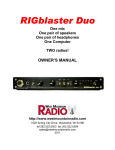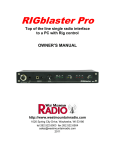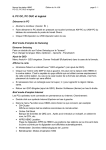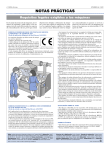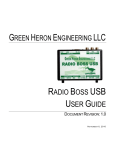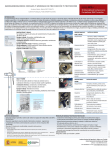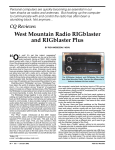Transcript
SHORT TAKES RIGblaster Plus Computer sound card interfaces began as basic units—they offered transmit/receive switching, audio matching and little else. But as more amateurs discovered that they could put their computers to work as multimode tools (PSK31, RTTY, SSTV, etc), there was a need for interfaces that could streamline station operations. The RIGblaster Plus from West Mountain Radio represents this new interface generation. The RIGblaster Plus essentially automates the entire interfacing process, bringing all switching and audio-routing functions under its control. Installation At about the size of a small paperback book, the RIGblaster Plus can find a home on just about any station desk or table. You’re supplied with all the cables you need, along with a “wall wart” 12-V dc power supply. As they say on TV, no additional purchase required. The first thing you have to do is configure the RIGblaster’s internal jumper block according to the wiring of your radio’s microphone jack. The RIGblaster Plus manual only provides jumper positions for radios with eight-pin round screw-on connectors. If your radio uses an RJ45 mike connector, you’ll need to get optional adapter cables. West Mountain Radio can provide details on the proper jumper settings for those transceivers. The rest of the installation is straightforward—a cable between the accessory jack on your transceiver and the computer sound card input for receive audio, and a cable from the sound card output to the RIGblaster Plus. There is a small potentiometer on the back panel that you can use to adjust the audio level to the interface. As long as you don’t change the sound card settings on your computer, this is a set-once-andforget operation. One Serial Port, Three Applications Unless an interface uses VOX switching, you need to run a serial cable between your computer COM port and the interface. This allows the computer to send transmit/receive switching pulses to the radio. The only problem arises when you want to use the computer serial port for FSK RTTY or CW keying. Now you have to disconnect the interface serial cable and install another, or use a serial switch to select between the sound card interface and your FSK or CW keying device. Not so with the RIGblaster Plus. The RIGblaster Plus automatically isolates and routes FSK and/or CW keying pulses from a single serial cable to ports on the back panel of the interface. So, a single serial cable does triple duty: microphone PTT switching (for modes such as AFSK RTTY, PSK31, MFSK16, SSTV and so forth), FSK keying and CW keying. When you have the RIGblaster installed, all of this is transparent. You simply boot up the software for the mode you desire and go—at least that’s how it should work. In my case, pilot error intervened. I had blithely ignored the little serial jumper block (separate from the main block) because I assumed that its default settings would work just Steve Ford, WB8IMY From December 2001 QST © ARRL fine for keying my transceiver using FSK in the RTTY mode. Wrong! Instead of the dulcet songs of RTTY, I was transmitting dead carriers. The problem boiled down to the fact that both of the RTTY programs I use (WriteLog and MMTTY) do their FSK keying using the TXD line on the computer’s serial port. I needed to reconfigure the RIGblaster Plus serial jumpers to allow the interface to work with the signals on the TXD line. The bright diagnostic LEDs inside the RIGblaster were a huge help. The moral of the story is to check and re-check the jumper blocks. Assume nothing. Automatic Microphone Switching If you operate the digital modes, you’ve probably heard hot mike syndrome more than once. That’s the condition where the operator is sending in his or her mode of choice (PSK31, for instance) without realizing that the microphone is on and operating at the same time. Hot mike syndrome treats the world to a symphony of audio from the unknowing ham—background music, very private conversations, you name it. Fortunately, this can’t happen when you’re using the RIGblaster Plus. Your microphone plugs into the RIGblaster and the RIGblaster controls audio routing to your radio. When you’re transmitting from your computer, the microphone is automatically cut off. However, you can still grab the mike and transmit, which will seize control of the interface and instantly interrupt the audio stream from your PC. I love this feature for SSTV contacts. I can hold the mike in one hand, click my computer mouse to send an image after I announce the mode, and then be ready to resume talking after the image is sent. Once again, no cables to connect or disconnect and no switches to manipulate. Conclusion Other RIGblaster Plus features worth noting include the /4-inch headphone jack on the front panel and a PTT/footswitch jack on the back panel. The RIGblaster Plus also comes with a CD-ROM that includes over 65 programs including freeware for almost every digital mode plus voice and analog modes. Besides performance and good looks, the RIGblaster Plus sets a new standard for convenience and elegance. Thanks to the RIGblaster’s ability to centralize the all audio and switching connections between your computer and your transceiver, what may have been a phone-only station can easily become a facility for CW, packet, SSTV, PSK31, RTTY, MFSK16 and more. Manufacturer: West Mountain Radio, 18 Sheehan Ave, Norwalk, CT 06854; 203-853-8080; www.westmountainradio.com. $139.95. 1 QST Editor
